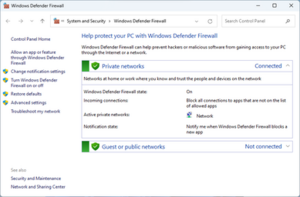|
Windows Firewall
Windows Firewall (officially called Microsoft Defender Firewall in Windows 10 version 2004 and later) is a firewall component of Microsoft Windows. It was first included in Windows XP SP2 and Windows Server 2003 SP1. Before the release of Windows XP Service Pack 2, it was known as the "Internet Connection Firewall." OverviewWhen Windows XP was originally shipped in October 2001, it included a limited firewall called "Internet Connection Firewall". It was disabled by default due to concerns with backward compatibility, and the configuration screens were buried away in network configuration screens that many users never looked at. As a result, it was rarely used. In mid-2003, the Blaster worm attacked a large number of Windows machines, taking advantage of flaws in the RPC Windows service.[1] Several months later, the Sasser worm did something similar. The ongoing prevalence of these worms through 2004 resulted in unpatched machines being infected within a matter of minutes.[1] Because of these incidents, as well as other criticisms that Microsoft was not being active in protecting customers from threats, Microsoft decided to significantly improve both the functionality and the interface of Windows XP's built-in firewall, rebrand it as Windows Firewall,[2] and switched it on by default since Windows XP SP2. One of three profiles is activated automatically for each network interface:[3]
Security log capabilities are included, which can record IP addresses and other data relating to connections originating from the home or office network or the Internet. It can record both dropped packets and successful connections. This can be used, for instance, to track every time a computer on the network connects to a website. This security log is not enabled by default; the administrator must enable it.[4] Windows Firewall can be controlled/configured through a COM object-oriented API, scriptable through the netsh command,[5] through the GUI administration tool[6] or centrally through group policies.[7] All features are available regardless of how it is configured. VersionsWindows NeptuneIn the unreleased Windows Neptune, the firewall was introduced[citation needed]. It is similar to the one found in Windows XP.[8] Windows XP Windows Firewall was first introduced as part of Windows XP Service Pack 2. Every type of network connection, whether it is wired, wireless, VPN, or even FireWire, has the firewall enabled by default, with some built-in exceptions to allow connections from machines on the local network. It also fixed a problem whereby the firewall policies would not be enabled on a network connection until several seconds after the connection itself was created, thereby creating a window of vulnerability.[9] A number of additions were made to Group Policy, so that Windows system administrators could configure the Windows Firewall product on a company-wide level. XP's Windows Firewall cannot block outbound connections; it is only capable of blocking inbound ones. Windows Firewall turned out to be one of the two most significant reasons (the other being DCOM activation security)[10] that many corporations did not upgrade to Service Pack 2 in a timely fashion. Around the time of SP2's release, a number of Internet sites were reporting significant application compatibility issues, though the majority of those ended up being nothing more than ports that needed to be opened on the firewall so that components of distributed systems (typically backup and antivirus solutions) could communicate. Windows Firewall added IPv6, which was not supported by its predecessor, Internet Connection Firewall.[11] Windows VistaWindows Vista improved the firewall to address a number of concerns around the flexibility of Windows Firewall in a corporate environment:[12]
Windows Server 2008 and Windows 7Windows Server 2008 contains the same firewall as Windows Vista. The firewall in Windows Server 2008 R2 and Windows 7 contains some improvements, such as multiple active profiles.[13] Windows 10Changes to this component in Windows 10 are:
See also
References
Notes
External links |
||||||||||||||||
